For readers of all ages looking for an escape from the ordinary, the new fantasy and science fiction books we review in this week’s column provide just the ticket for adventures rooted in the “real” world (with magical twists) as well as in imaginative realms created by the expert world-building talents of authors and illustrators.
Ages 4–8
Backyard Fairies. Phoebe Wahl. 2018. Knopf/Random House.
 A young girl hunts in her backyard and woods for signs of fairies and other magical creatures. “Have you ever found, while out on your own … / A tiny, magical somebody’s home?” In addition to enjoying the gentle, rhyming text directed at them, readers will delight in seeing what the girl does not in the earthy illustrations (created with water color, gouache, collage, and colored pencils): fairies in trees, pixies braiding her dog’s hair, a cave of magical creatures under her feet. After sneaking out of bed one night to follow the music of elusive magical sprites, she returns home, wondering if they really exist, and awakens in the morning with a special crown of flowers in her hair.
A young girl hunts in her backyard and woods for signs of fairies and other magical creatures. “Have you ever found, while out on your own … / A tiny, magical somebody’s home?” In addition to enjoying the gentle, rhyming text directed at them, readers will delight in seeing what the girl does not in the earthy illustrations (created with water color, gouache, collage, and colored pencils): fairies in trees, pixies braiding her dog’s hair, a cave of magical creatures under her feet. After sneaking out of bed one night to follow the music of elusive magical sprites, she returns home, wondering if they really exist, and awakens in the morning with a special crown of flowers in her hair.
—NB
Cat Wishes. Calista Brill. Ill. Kenard Pak. 2018. Houghton Mifflin.
 A hungry cat wishing for something to eat as he prowls through the woods pounces on a wiggly snake. Although Cat doesn’t believe the snake’s promise to grant him three wishes for its release, he lets Snake go. While continuing to voice his skepticism, Cat gets three wishes: something to appease his hunger (a fish), somewhere to shelter from the rain (a cozy house), and a friend. The friend turns out to be a small girl whose wishes for the same things were also granted by Snake. Calista Brill’s spare, repetitive text peppered with onomatopoeic words and Kenard Pak’s soft edge watercolor and digital media illustrations make this animal fantasy a good read-aloud choice.
A hungry cat wishing for something to eat as he prowls through the woods pounces on a wiggly snake. Although Cat doesn’t believe the snake’s promise to grant him three wishes for its release, he lets Snake go. While continuing to voice his skepticism, Cat gets three wishes: something to appease his hunger (a fish), somewhere to shelter from the rain (a cozy house), and a friend. The friend turns out to be a small girl whose wishes for the same things were also granted by Snake. Calista Brill’s spare, repetitive text peppered with onomatopoeic words and Kenard Pak’s soft edge watercolor and digital media illustrations make this animal fantasy a good read-aloud choice.
—CA
The Dragon and the Nibblesome Knight. Elli Woollard. Ill. Benji Davies. 2018. Godwin/Henry Holt.
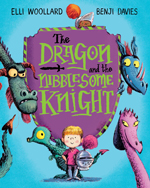 While flying through a storm in search of “a bite of a dribblesome, nibblesome, knobble-kneed knight” (the favorite food of Dragons of Dread), Dram, a small green dragon, crashes into a lake. James, a young knight who has never seen a dragon, strips off his armor and rescues what he thinks is some rare kind of duck. When they meet again on Sports Day at the castle, their true identities are revealed. Will Dram bite? Will James fight? Their model of good behavior leads the knights of the kingdom to recognize that dragons aren’t simply beasts and the dragons to vow not to nibble on knights—"though every so often, they sort of . . . forgot.” Colorful, detailed cartoon artwork adds to the fun of reading this delightful tale of mistaken identity and friendship.
While flying through a storm in search of “a bite of a dribblesome, nibblesome, knobble-kneed knight” (the favorite food of Dragons of Dread), Dram, a small green dragon, crashes into a lake. James, a young knight who has never seen a dragon, strips off his armor and rescues what he thinks is some rare kind of duck. When they meet again on Sports Day at the castle, their true identities are revealed. Will Dram bite? Will James fight? Their model of good behavior leads the knights of the kingdom to recognize that dragons aren’t simply beasts and the dragons to vow not to nibble on knights—"though every so often, they sort of . . . forgot.” Colorful, detailed cartoon artwork adds to the fun of reading this delightful tale of mistaken identity and friendship.
—CA
The Yin-Yang Sisters and the Dragon Frightful. Nancy Tupper Ling. Ill. Andrea Offermann. 2018. Putnam/Penguin.
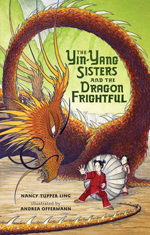 On the very day that twins Wei and Mei were born in the village of Woo, a dragon named Frightful stretched his long, scaly body across the Dan-Tat Bridge, blocking the villagers’ passage across a gorge. Nothing would budge him. From birth the different personalities of the twins were evident, and their Auntie YiYi predicted that they would grow up to fight the dragon together. And finally they do, but in a surprising way. “‘With a little yin,’ said Wei. ‘And a little yang’ said Mei. ‘Together we make the perfect pair.”’ Andrea Offermann’s intricately detailed illustrations, rendered in pen and ink and watercolor, beautifully picture the scene for this tale set in ancient China. Adults reading this picture book to young children may want to talk about the Chinese philosophy of Yin and Yang with them.
On the very day that twins Wei and Mei were born in the village of Woo, a dragon named Frightful stretched his long, scaly body across the Dan-Tat Bridge, blocking the villagers’ passage across a gorge. Nothing would budge him. From birth the different personalities of the twins were evident, and their Auntie YiYi predicted that they would grow up to fight the dragon together. And finally they do, but in a surprising way. “‘With a little yin,’ said Wei. ‘And a little yang’ said Mei. ‘Together we make the perfect pair.”’ Andrea Offermann’s intricately detailed illustrations, rendered in pen and ink and watercolor, beautifully picture the scene for this tale set in ancient China. Adults reading this picture book to young children may want to talk about the Chinese philosophy of Yin and Yang with them.
—CA
Ages 9–11
The Spinner Prince (Pride Wars #1). Matt Laney. 2018. Houghton Mifflin.
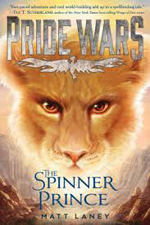 Thirteen-year-old Leo, heir to the throne of Singara, a futuristic world of highly evolved lions, must keep secret that he is a Spinner, a teller of tales. In a society that believes only in science and fact, discovery that he has this uncontrollable “fiction affliction” would result in exile. Leo faces threats from both outside and within the walled kingdom. Are the Maguar planning an invasion? Is his life under threat from Tamir, his older cousin who has named himself the new Singa-Kahn? Leo will need to use his special magical power as a Spinner to save himself and Singara’s future. Laney includes a list of folktales from different cultures and traditions upon which the stories Leo tells in this first book of his action-packed animal fantasy series are based.
Thirteen-year-old Leo, heir to the throne of Singara, a futuristic world of highly evolved lions, must keep secret that he is a Spinner, a teller of tales. In a society that believes only in science and fact, discovery that he has this uncontrollable “fiction affliction” would result in exile. Leo faces threats from both outside and within the walled kingdom. Are the Maguar planning an invasion? Is his life under threat from Tamir, his older cousin who has named himself the new Singa-Kahn? Leo will need to use his special magical power as a Spinner to save himself and Singara’s future. Laney includes a list of folktales from different cultures and traditions upon which the stories Leo tells in this first book of his action-packed animal fantasy series are based.
—CA
The Stone Girl’s Story. Sarah Beth Durst. 2018. Clarion/Houghton Mifflin.
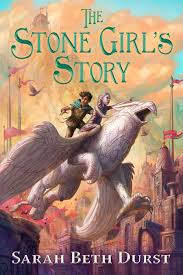 Twelve-year-old stone girl Mayka, created by her master stonemason human father (who also carved her living stone animal companions), worries when Turtle’s marks fade and he stops moving. With her father dead and no one to repair the unique marks that tell their stories and give them life, Mayka leaves her secluded mountain home, accompanied by flying stone birds Risa and Jacklo, to find a stonemason to save them. Arriving in the city of Skye as it prepares for the Stone Festival and where strict rules limit the power and actions of carvers, she uncovers the sinister plot of a stone carver engraving illegal obedience marks into a secret army of cretures and a giant monster. Mayka makes allies and uncovers unexpected solutions to thwart the enslavement of all stone animals as well as to save her friends in this adventurous fantasy.
Twelve-year-old stone girl Mayka, created by her master stonemason human father (who also carved her living stone animal companions), worries when Turtle’s marks fade and he stops moving. With her father dead and no one to repair the unique marks that tell their stories and give them life, Mayka leaves her secluded mountain home, accompanied by flying stone birds Risa and Jacklo, to find a stonemason to save them. Arriving in the city of Skye as it prepares for the Stone Festival and where strict rules limit the power and actions of carvers, she uncovers the sinister plot of a stone carver engraving illegal obedience marks into a secret army of cretures and a giant monster. Mayka makes allies and uncovers unexpected solutions to thwart the enslavement of all stone animals as well as to save her friends in this adventurous fantasy.
—NB
Ages 12–14
The Door to the Lost. Jaleigh Johnson. 2018. Delacorte/Random House.
 Rook, who can draw doors with chalk to other dimensions, and best friend Drift, who has tricks of her own, were among the magical children in the skyship that sailed from the world of Vora into Regara City in the world of Talhaven just before the portal arch connecting the two worlds exploded. With no memories or family, Rook and Drift have grown up refugees in a land that distrusts magic of any kind and survive by transporting others to safer places. When a young fox-turned-boy bursts through one of the doors and joins them as they elude rangers, their lives intertwine with the wizard Dozana, who tries for the biggest power grab of all, enough magic to destroy Regara, before escaping to a new world. It falls on Rook, Drift, and Fox to use their returning memories and magical powers to save their adopted world.
Rook, who can draw doors with chalk to other dimensions, and best friend Drift, who has tricks of her own, were among the magical children in the skyship that sailed from the world of Vora into Regara City in the world of Talhaven just before the portal arch connecting the two worlds exploded. With no memories or family, Rook and Drift have grown up refugees in a land that distrusts magic of any kind and survive by transporting others to safer places. When a young fox-turned-boy bursts through one of the doors and joins them as they elude rangers, their lives intertwine with the wizard Dozana, who tries for the biggest power grab of all, enough magic to destroy Regara, before escaping to a new world. It falls on Rook, Drift, and Fox to use their returning memories and magical powers to save their adopted world.
—NB
Magic, Madness, and Mischief. Kelly McCullough. 2018. Feiwel and Friends.
 Thirteen-year-old Kalvan Monroe’s ordinary life flips upside down when he discovers that he has fire magic with the gift of persuasion, that he has bound Sparx (a snarky, ageless, talking fire hare) to him, and that his evil, controlling stepfather is the true Winter King. If that isn’t enough, his emotionally fragile mother may have some magic of her own, but her ability to function in is dissipating quickly. Kalvan, Thomas (his best friend), and Sparx must solve three clues to recapture the hidden Corona Borealis before the culmination of the Saint Paul Winter Carnival—and bring down the Winter King—or the crown will not be passed on to Summer, resulting in dangerous consequences for earth’s climate and seasons. This imaginative middle-grade fantasy will engage readers with its non-stop action and healthy dose of humor.
Thirteen-year-old Kalvan Monroe’s ordinary life flips upside down when he discovers that he has fire magic with the gift of persuasion, that he has bound Sparx (a snarky, ageless, talking fire hare) to him, and that his evil, controlling stepfather is the true Winter King. If that isn’t enough, his emotionally fragile mother may have some magic of her own, but her ability to function in is dissipating quickly. Kalvan, Thomas (his best friend), and Sparx must solve three clues to recapture the hidden Corona Borealis before the culmination of the Saint Paul Winter Carnival—and bring down the Winter King—or the crown will not be passed on to Summer, resulting in dangerous consequences for earth’s climate and seasons. This imaginative middle-grade fantasy will engage readers with its non-stop action and healthy dose of humor.
—NB
Ages 15+
The Apocalypse of Elena Mendoza. Shaun David Hutchinson. 2018. Simon Pulse/Simon & Schuster.
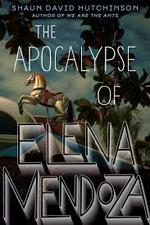 Few believe that 16-year-old Elena Mendoza was the product of a virgin birth, but after she heals Freddie (a girl on whom she’s had a crush) from a bullet wound and the shooter is “raptured” up in a bright beam of light, things change. Elena struggles to ignore the voices of inanimate objects (the siren on the Starbucks coffee mug, My Little Pony, Lego Gandolf) telling her she has been chosen to save humanity, but with people raptured worldwide in increasing numbers after each healing, her best friend, Fadil, a devout Muslim boy, believes her gift is from God. Elena is not sure. As the FBI investigates her, people continue to beg for healings, and Carmen Ballard, an attorney, hires Elena’s weak stepfather to kidnap her for an anonymous client, Elena finally devises a plan that will either save or end the world in this inventive and thought-provoking fantasy.
Few believe that 16-year-old Elena Mendoza was the product of a virgin birth, but after she heals Freddie (a girl on whom she’s had a crush) from a bullet wound and the shooter is “raptured” up in a bright beam of light, things change. Elena struggles to ignore the voices of inanimate objects (the siren on the Starbucks coffee mug, My Little Pony, Lego Gandolf) telling her she has been chosen to save humanity, but with people raptured worldwide in increasing numbers after each healing, her best friend, Fadil, a devout Muslim boy, believes her gift is from God. Elena is not sure. As the FBI investigates her, people continue to beg for healings, and Carmen Ballard, an attorney, hires Elena’s weak stepfather to kidnap her for an anonymous client, Elena finally devises a plan that will either save or end the world in this inventive and thought-provoking fantasy.
—NB
Ink, Iron, and Glass (Ink, Iron, and Glass #1). Gwendolyn Clare. 2018. Imprint/Macmillan.
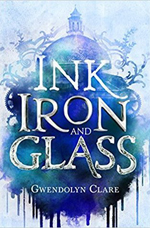 Sixteen-year-old Elsa lives on Veldana, a new world written into reality by a 19th-century French scriptologist, Charles Montaigne. Her mother, Jumi, a scriptologist, has continued expanding Veldana by writing in its worldbook, and is training Elsa to become its caretaker. When the Veldana worldbook is stolen and Jumi abducted, Elsa travels to Earth through a portal to locate the worldbook and rescue her mother. Fearing for her safety, De Vries, a friend of Jumi, settles Elsa in at Casa della Pazzia, a residence for children with special talents in three branches of science: scriptology, mechanics, or alchemy.With three gifted allies she makes in the Casa, Elsa embarks on a dangerous mission to find and rescue her mother that will also involve them in a diabolical political conspiracy. The author’s note provides a context for this steampunk fantasy that provides an alternate history of actual political conflict over unification in 19th-century Italy. A sequel, Mist, Metal, and Ash, will be out in February 2019.
Sixteen-year-old Elsa lives on Veldana, a new world written into reality by a 19th-century French scriptologist, Charles Montaigne. Her mother, Jumi, a scriptologist, has continued expanding Veldana by writing in its worldbook, and is training Elsa to become its caretaker. When the Veldana worldbook is stolen and Jumi abducted, Elsa travels to Earth through a portal to locate the worldbook and rescue her mother. Fearing for her safety, De Vries, a friend of Jumi, settles Elsa in at Casa della Pazzia, a residence for children with special talents in three branches of science: scriptology, mechanics, or alchemy.With three gifted allies she makes in the Casa, Elsa embarks on a dangerous mission to find and rescue her mother that will also involve them in a diabolical political conspiracy. The author’s note provides a context for this steampunk fantasy that provides an alternate history of actual political conflict over unification in 19th-century Italy. A sequel, Mist, Metal, and Ash, will be out in February 2019.
—CA
When Light Left Us. Leah Thomas. 2018. Bloomsbury.
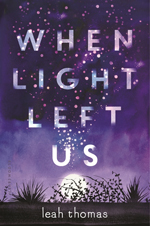 The Vasquez children are in mourning after Donovan, their dad, leaves, but when Luz, a shimmering figure, appears in the New Mexico canyon behind their home, he fills that grief as a father-substitute who brings personal gifts: basketball prowess for 17-year-old Luke, vivid memory images for 14-year-old Ana, and friendship for 8-year-old autistic Milo. However, as Luz’s plays with their minds and then leaves them, each sibling loses something precious, and the void is back. In an unexpected unfolding of events, the family learns that Luz is a parasitic alien who manipulates humans only to learn more about, and to control, them—so when he returns, they know he must be stopped. And their mother, Maggie, is concealing a secret that will change everything they think they know in their struggle as a family to understand the truth and heal.
The Vasquez children are in mourning after Donovan, their dad, leaves, but when Luz, a shimmering figure, appears in the New Mexico canyon behind their home, he fills that grief as a father-substitute who brings personal gifts: basketball prowess for 17-year-old Luke, vivid memory images for 14-year-old Ana, and friendship for 8-year-old autistic Milo. However, as Luz’s plays with their minds and then leaves them, each sibling loses something precious, and the void is back. In an unexpected unfolding of events, the family learns that Luz is a parasitic alien who manipulates humans only to learn more about, and to control, them—so when he returns, they know he must be stopped. And their mother, Maggie, is concealing a secret that will change everything they think they know in their struggle as a family to understand the truth and heal.
—NB
Nancy Brashear is Professor Emeritus of English from Azusa Pacific University, in Azusa, California. Carolyn Angus is former director of the George G. Stone Center for Children's Books, Claremont Graduate University, in Claremont, California.
These reviews are submitted by members of the International Literacy Association's Children's Literature and Reading Special Interest Group (CL/R SIG) and are published weekly on Literacy Daily.